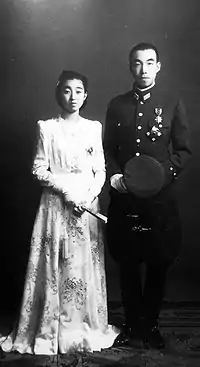Shigeko Higashikuni
Shigeko Higashikuni (東久邇 成子, Higashikuni Shigeko, 6 December 1925 – 23 July 1961), born Shigeko, Princess Teru (照宮成子内親王, Teru-no-miya Shigeko Naishinnō), was the wife of Prince Morihiro Higashikuni and eldest daughter of Emperor Shōwa and Empress Kōjun. She was the eldest sister to Japan's Emperor Emeritus Akihito.[1][2]
| Shigeko Higashikuni | |
|---|---|
.jpg.webp) Shigeko Higashikuni in 1960 | |
| Born | Shigeko (成子) 6 December 1925 Akasaka Palace, Tokyo City, Empire of Japan |
| Died | 23 July 1961 (aged 35) Imperial Household Agency Hospital, Tokyo, Japan |
| Burial | 4 August 1961 Toshimagaoka Imperial Cemetery, Bunkyō |
| Spouse | |
| Issue |
|
| House | Imperial House of Japan (until 1947) |
| Father | Emperor Shōwa |
| Mother | Empress Kōjun |
Biography
Princess Shigeko was born at Akasaka Palace in Tokyo while her father was still Prince Regent for her grandfather the Taishō Emperor.[3] Her childhood appellation was Teru-no-miya (照宮) ("Princess Teru"). As was the practice of the time, she was not raised by her biological parents after the age of three, but by a succession of court ladies at a separate palace built for her and her younger sisters in the Marunouchi district of Tokyo from 1930. Emperor Shōwa opposed the move, but could not defy court tradition.[4] She entered the girls elementary department of the Gakushūin Peer's School in 1932 and completed the secondary department in 1942, learning cooking and literature.
On 9 May 1939, Princess Shigeko rode on the Chōshi Electric Railway Line in Chiba Prefecture from Chōshi to Tōdaimae and back as part of a Gakushūin school outing.[5]
In 1941, she was formally engaged to the eldest son and heir of Prince Naruhiko Higashikuni, Prince Morihiro Higashikuni. The bride and groom were double first cousins once removed, through both the main imperial line, in descent from Emperor Meiji (the bride's maternal grandfather and the groom's father were siblings; meaning that the groom was a first cousin of the bride's father), and through collateral imperial lines, or ōke, that were cadet branches of the Fushimi-no-miya cadet branch of the imperial house.[1] The couple were officially wed on 10 October 1943. As the wedding occurred in the middle of World War II, ceremonies and expenses were kept to a minimum, and she wore a junihitoe kimono belonging to her mother, Empress Kōjun, rather than having special clothing created for the occasion.
In 1947, the Higashikunis were reduced to commoner status with the abolition of titles of nobility by the American occupation forces. With rampant post-war inflation, high taxation, and various failed business ventures by her husband, the Higashikuni family was reduced to poverty. In January 1958, she accepted an offer by the Japanese national television network, NHK, to appear before a live audience and explain the New Year's poetry card reading contest and other royal ceremonies. She fell ill in 1960, complaining of stomach pains, and was diagnosed with cancer. Hospitalized at the Imperial Household Agency Hospital in Tokyo, she died on 23 July 1961.[6] Her grave is at the Toshimagaoka imperial cemetery in Bunkyo, Tokyo.
Family

Prince and Princess Higashikuni had five children, the last three of whom were born after they were reduced in status to commoners:[7]
- Prince Nobuhiko Higashikuni (東久邇宮 信彦王, Higashikuni-no-miya Nobuhiko ō) (born 10 March 1945, died 20 March 2019); married 1973 Miss Shimada Yoshiko, with one son, Higashikuni Yukihiko (b. 1974)
- Princess Fumiko Higashikuni (文子女王, Fumiko joō, born 23 December 1946); married Mr. Omura Kazutoshi.
- Hidehiko Higashikuni (東久邇 秀彦, born 30 June 1949): adopted by the Mibu family as "Mibu Motohiro"
- Naohiko Higashikuni (東久邇 真彦, born 1953); married to Ms. Sato Kazuko, with two sons, Teruhiko and Mutsuhiko
- Yūko Higashikuni (東久邇 優子, born 1954) Married.
Honours
National honours
- Grand Cordon of the Order of the Precious Crown
Ancestry
| Ancestors of Shigeko Higashikuni | |||||||||||||||||||||||||||||||||||||||||||||||||||||||||||||||||||||||||||||||||||||||||||||||||||||||||||||||||||||||||||||||||||||||||||||||||||||||||||||||||||||||||||||||||||||||||||||||||||||||||||||||||||||||||||||||||||||||||||||||||||||||||||||||||||||||||||||||||||||||||
|---|---|---|---|---|---|---|---|---|---|---|---|---|---|---|---|---|---|---|---|---|---|---|---|---|---|---|---|---|---|---|---|---|---|---|---|---|---|---|---|---|---|---|---|---|---|---|---|---|---|---|---|---|---|---|---|---|---|---|---|---|---|---|---|---|---|---|---|---|---|---|---|---|---|---|---|---|---|---|---|---|---|---|---|---|---|---|---|---|---|---|---|---|---|---|---|---|---|---|---|---|---|---|---|---|---|---|---|---|---|---|---|---|---|---|---|---|---|---|---|---|---|---|---|---|---|---|---|---|---|---|---|---|---|---|---|---|---|---|---|---|---|---|---|---|---|---|---|---|---|---|---|---|---|---|---|---|---|---|---|---|---|---|---|---|---|---|---|---|---|---|---|---|---|---|---|---|---|---|---|---|---|---|---|---|---|---|---|---|---|---|---|---|---|---|---|---|---|---|---|---|---|---|---|---|---|---|---|---|---|---|---|---|---|---|---|---|---|---|---|---|---|---|---|---|---|---|---|---|---|---|---|---|---|---|---|---|---|---|---|---|---|---|---|---|---|---|---|---|---|---|---|---|---|---|---|---|---|---|---|---|---|---|---|---|---|---|---|---|---|---|---|---|---|---|---|---|---|---|---|---|---|
| |||||||||||||||||||||||||||||||||||||||||||||||||||||||||||||||||||||||||||||||||||||||||||||||||||||||||||||||||||||||||||||||||||||||||||||||||||||||||||||||||||||||||||||||||||||||||||||||||||||||||||||||||||||||||||||||||||||||||||||||||||||||||||||||||||||||||||||||||||||||||
Gallery
 Crown Prince Hirohito and Crown Princess Nagako with their first daughter, Princess Shigeko in 1926.
Crown Prince Hirohito and Crown Princess Nagako with their first daughter, Princess Shigeko in 1926. Emperor Shōwa's daughters
Emperor Shōwa's daughters Emperor Shōwa's family (7 December 1941)
Emperor Shōwa's family (7 December 1941) Princess Shigeko in 1941
Princess Shigeko in 1941 Princess Shigeko in 1941
Princess Shigeko in 1941
References
- "Deceased and former members of the Imperial family". Archived from the original on October 27, 2009. Retrieved October 27, 2009.CS1 maint: bot: original URL status unknown (link).
- Bix, Hirohito and the Making of Modern Japan. page 145.
- "Delicate Piety." Time Magazine, December 13, 1926. Retrieved on November 30, 2008.
- Bix, Hirohito and the Making of Modern Japan. Pages 270–271
- Shirato, Sadao (July 2011). 銚子電気鉄道(下) [Choshi Electric Railway Volume Two]. Japan: Neko Publishing Co., Ltd. p. 16. ISBN 978-4-7770-5310-0.
- Large, Emperor Hirohito and Showa Japan, page 165.
- 東久邇宮家 (in Japanese). nekhet. Retrieved October 14, 2011.
- Bix, Herbert P. (2001). Hirohito and the Making of Modern Japan. Harper Perennial. ISBN 0-06-093130-2.
- Large, Stephen S (1992). Emperor Hirohito and Shōwa Japan: A Political Biography. Routledge. ISBN 0-415-03203-2.
External links
| Wikimedia Commons has media related to Higashikuni Shigeko. |
